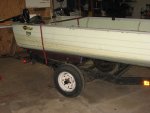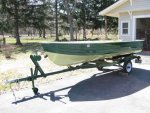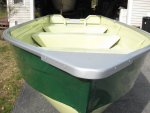Old Gamefisher
Seaman
- Joined
- Apr 20, 2009
- Messages
- 51
I have a 14' Gamefisher riveted aluminum boat which I plan to paint someday. When the boat was given to me (I'm finding that there's no such thing as a free boat), it was full of rainwater, and not leaking a drop. I'd like to seal the seams with Gluvit anyway, because I think that as the boat finally sees some use, the seams will loosen up. Good idea/bad idea? The boat is painted gray on the inside (factory?), but there are some areas of rust staining (anchor) that I sanded and wire brushed.
What kind of prep do I need to do before applying Gluvit? Do I need to go as far as pre-painting prep, down to bare metal/acid wash?
What kind of prep do I need to do before applying Gluvit? Do I need to go as far as pre-painting prep, down to bare metal/acid wash?























